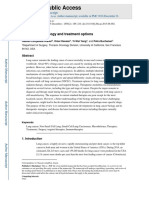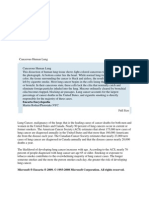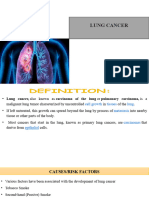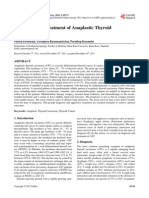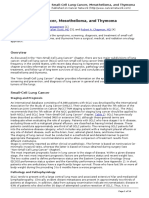IJHSR42
IJHSR42
Uploaded by
pntoe4imliCopyright:
Available Formats
IJHSR42
IJHSR42
Uploaded by
pntoe4imliCopyright
Available Formats
Share this document
Did you find this document useful?
Is this content inappropriate?
Copyright:
Available Formats
IJHSR42
IJHSR42
Uploaded by
pntoe4imliCopyright:
Available Formats
International Journal of Health Sciences and Research
Vol.13; Issue: 10; October 2023
Website: www.ijhsr.org
Review Article ISSN: 2249-9571
Lung Cancer - A Review
V. Sankar1, R. Kothai2, N. Vanisri1, Akilandeswari. S1, G. Anandharaj3
1
Department of Pharmacology, Srinivasan College of Pharmaceutical Sciences, Samayapuram,
Tamilnadu-6211112
2
Department of Pharmacology, Vinayaka Mission’s College of Pharmacy, Yearcaud Main Road
Kondappanaikanpatty, Salem, Tamilnadu. -636008
3
Department of Pharmacology, Vellalar College of Pharmacy, Maruthi Nagar, Thindal, Erode,
Tamil Nadu 638012
Corresponding Author: V. Sankar
DOI: https://doi.org/10.52403/ijhsr.20231042
ABSTRACT
Lung cancer is the prime cause of cancer death among both men and women according to WHO
report 2.09 million cases globally. It is also the chief cause of cancer death among men and the second
leading cause of cancer death among women worldwide. The lung cancer classified into two different
types are small-cell lung cancers (SCLC) and non-small-cell lung cancers (NSCLC). Non-small cell
lung cancer is more common than small cell lung cancer. Treatment of lung cancer may involve a
combination of surgery, chemotherapy, targeted therapy, immunotherapy, and radiation therapy.
Therapeutic recommendations depend on several factors, including stage and type of cancer. Low-
and middle-income countries now account for more than 50 % of lung cancer deaths each year the
responses to current standard therapies are poor except for the most localized cancers. The purpose of
this review is to sum up the types, epidemiology, detection, metastasis and the treatment of lung
cancer.
Key words: WHO, SCLC, NSCLC, Epidemiology, Metastasis
INTRODUCTION First location of spread in most of the lung
Cancer is not just one disease, but a generic cancer patients is lymph nodes. Pre-
term used to encompass a group of more operative assessment of spread to lymph
than two hundred diseases sharing common nodes is important for consideration of
characteristics. Cancers (carcinomas) are further treatment. Lymph nodes will be
characterized by their unregulated growth removed during surgery to be analyzed
and spread of cells to other parts of the using light microscopy for review. If there
body [1, 2]. are areas of tumor cells in lymph nodes, the
Lung cancer is one of the most common patient is offered additional chemotherapy.
cancers we have and a large number of In most cases the spread of cancer to lymph
people die of this disease every year. The nodes remains unnoticed due to insensitivity
disease is often discovered in a late stage, of the clinical methods and the patients have
but also in earlier stages lung cancer low survival rate even after the diagnosis.
patients have worse outcome than patients More advanced and sensitive methods are
with other cancers. Even without spreading needed to help this out. Lung Cancer, like
to other organs, during stage I, the survival all other cancers, results from an acquired
rate of lung cancer is under 70%. In abnormality in the body's basic unit of life,
comparison, for example, breast cancer the cell. Normally, the body maintains a
there is 95% survival in stage [3] system of control mechanisms for cell
International Journal of Health Sciences and Research (www.ijhsr.org) 307
Volume 13; Issue: 10; October 2023
V. Sankar et.al. Lung cancer – a review
growth, so that cells divide to produce new of large bronchus [14] the cells multiply
cells only when new cells are needed [4] quickly and form large tumors that spread
Disruption of this control system results in throughout the body [15]
an uncontrolled division and proliferation of
cells that eventually forms a mass known as Non-small cell lung cancer (NSCLC): It
a tumor. Although it can arise in any part of is the most common type of lung cancers
the lung; 90%-95% of the lung cancers arise and accounts for about80% of all lung
from epithelial cells, bronchi and cancers. NSCLC can be divided into three
bronchioles Sometimes it may also arise main types:
from the other supporting tissues within the
lungs like blood vessels5. Lung cancers Adenocarcinomas: This is found in the
arise through a multistep process involving gland of the lung that produces mucous and
many genetic and epigenetic changes that is the most common type of NSCLC in
includes damage of many key cell-cycle Women and nonsmokers [16]
genes [6]. Adenocarcinomas comprise up to 50 % of
The alterations may accumulate in bronchial NonSmall Cell Lung cancers and it arises in
epithelium leading to clonal cell expansion. the outer, or peripheral, areas of the lung.
In some cancer patients clonal cells does Asubtype of it is Bronchioloalveolar
not exist only as malignant cells but also Carcinoma that develops frequently at
as histologically normal appearing areas multiple sites in the lungs and spreads along
adjacent to tumors[7,8] the preexisting alveolar walls [17]
Some cancer patients demonstrate Sometimes adenocarcinomas arise around a
chromosomal abnormalities that damage scar tissue and are associated with asbestos
tumor suppressor genes or have mutations exposure [18]
in oncogenes [9] The mutations are
common at chromosome regions 3p (that Squamous Cell Carcinomas: These are
includes the FHIT, a tumor suppressor gene also known as epidermoid carcinomas and
mutated in over 70% lung cancers), 9p (that accounts for about 30-40% of primary lung
includes p16INK4a, p19ARF genes, which tumors [19]. This type of cancer grows
are involved in the RB signaling pathway), commonly in the central areas around major
13q (RB) and 17p (TP53)[ 10] bronchi in a stratified or pseudoductal
arrangement. The cells have an epithelial
Classification of lung cancer [11] pearl formation with individual cell
Lung cancers are broadly classified into two keratinization [20]
types:
Small cell lung cancers (SCLC) Large Cell Carcinomas:
Non-small cell lung cancers (NSCLC) The tumor cells are large and show no
other specific morphological traits.
Small cell lung cancer (SCLC): Sometimes they are referred to as
It is one of the most aggressive and rapidly undifferentiated carcinomas, and they are
growing lung cancers comprising 20% of all the least common type of Non-Small Cell
lung cancers [12] This type of cancer is Lung Cancer. [21]
strongly related to cigarette smoking. SCLC The prognosis and treatment options depend
often metastasizes rapidly too many sites on how widespread the disease is when
and is discovered during late stages. These diagnosed. The TNM classification system
cancers have a specific cell appearance is used to subgroup the patients according
under the microscope, the cells being to the extent of the disease. The method
smaller than the cells of Non-Small Cell classifies patients based on the size of
lung Cancer [13] SCLC often remains primary tumor (T), degree of spread to
central to the lung and grows along the wall lymph nodes (N) or distant spread at the
International Journal of Health Sciences and Research (www.ijhsr.org) 308
Volume 13; Issue: 10; October 2023
V. Sankar et.al. Lung cancer – a review
time of surgery (M). TNM classification is with 90 % of lung cancers arising because
crucial for further treatment options and of tobacco use. The five-year survival rate
must be present before treatment is initiated. is up to 65% among the patients of NSCLC
[22] where the disease is detected in early stages
but the long-term survival rate is 1% for
T-stage those having metastases. The prognosis for
This stage considers mainly the size adenocarcinoma is poorer than for
of the primary tumor. From TX squamous cell carcinoma, whereas for large
(positive cytology, but unknown tumor) cell carcinoma it is poorest. Lung cancer is
and T0 (not detected primary tumor) to T3 one of the commonest cancers and cause of
(tumor> 7 cm) and T4 (tumor invading cancer related deaths all over the world. It
surrounding organ areas). accounts for 13 per cent of all new cancer
cases and 19 per cent of cancer related
N-stage deaths worldwide. There were 1.8 million
o NX - Regional lymph nodes cannot be new lung cancer cases estimated to occur in
assessed 20121. In India, lung cancer constitutes 6.9
o N0 - no lymph node metastases per cent of all new cancer cases and 9.3 per
o N1 – The cancer has spread to lymph cent of all cancer related deaths in both
nodes within the lung and/or around the sexes, It is the commonest cancer and cause
area where the bronchus enters the lung of cancer related mortality in men, with the
(hilar lymph nodes) Metastasis to lymph highest reported incidences from Mizoram
nodes is on the same side as the primary in both males and females (Age adjusted
tumor. [ 23] rate 28.3 and28.7 per 100,000 population in
o N2 – The cancer has spread to lymph males and females, respectively. The time
nodes around the carina (point where the trends of lung cancer show a significant rise
windpipe splits into the left and right in Delhi, Chennai and Bangalore in both
bronchi) or in the space behind the sexes [27]
breast bone and in front of the heart
(mediastinum. Metastasis to mediastinal Clinical manifestation of Lung Cancer
nodes is on the same side as the primary There are several symptoms connected with
tumor. [24] the presence of Lung Cancer that vary
o N3 - Metastasis to nodes on the opposite depending upon where and how widespread
side of the lungs. the tumor is:
M-stage Symptoms related to the primary
o MX - distant spread cannot be assessed tumor:
o M0 - no distant metastases The growth and invasion of cancer in the
o M1 - distant metastases lung tissues and other surrounding areas
o M1a - distant spread to the lung on the may interfere with breathing that leads to
opposite side of the main tumor some symptoms such as
o M1b - distant metastases. [25] o Cough,
o Shortness of breath,
Epidemiology o Wheezing,
Lung Cancer is predominantly a disease of o Chest pain
the elder persons. Nearly 70% of people o Coughing up blood (hemoptysis).
diagnosed with lung cancer are above 65 o In case the cancer has invaded nerves it
years of age and less than 3% of lung may cause
cancers occur in the people below age of 45 o Shoulder pain that travels down the arm
years. [26] The incidence of lung cancer is (Pan Coast’s syndrome) paralysis of the
strongly correlated with cigarette smoking, vocal cords leading to hoarseness.
International Journal of Health Sciences and Research (www.ijhsr.org) 309
Volume 13; Issue: 10; October 2023
V. Sankar et.al. Lung cancer – a review
o If it invades to esophagus Detection Strategies [31, 32]
o It may cause difficulty in swallowing Detection and Isolation of Lymph Nodes:
(dysphasia). Lymph nodes are collected by the
pathologists in the resection specimen by
Symptoms related to metastasis: palpation and visual inspection. Following
If the lung cancer has spread to bones their detection lymph node biopsy is used to
o It may cause excruciating pain in the remove lymph nodes. The specimens are
bones. then formalin fixed and paraffin embedded.
o In case of spreading to bones it causes In this process lymph nodes are cut during
number of neurologic symptoms that the surgery of patients having lung
may include blurred vision, headaches, cancer. The isolated lymph nodes are
seizures, or, symptoms of stroke such further analyzed for the presence or absence
as weakness or loss of sensation in of tumor cells.
parts of the body. [28]
Detection of metastases in Lymph Nodes:
Paraneoplastic symptoms: The sections of isolated lymph nodes are
Most frequently lung cancers are analyzed using various methods to follow
accompanied by symptoms that result from the spread of the disease. Some of these
production of hormone-like substances by methods are described below:
the tumor cells.
o The paraneoplastic syndromes occur Routine analysis (H&Estainig)
most commonly with SCLC but in some Hematoxylin-eosin staining (H & E
cases it may also be seen with some staining) is based on staining of tissue
other type of tumor. sections by hematoxylin and eosin dyes,
o A release of parathyroid hormone like making it easier to distinguish different
substance is the most frequent types of cells visually. The method is not
paraneoplastic syndrome seen with sensitive enough to detect small metastases
NSCLC. The release of this substance but it can distinguish cancer cells from
leads to elevated levels of calcium in the healthy cells by looking at the cells’ shape,
blood stream [29] size and growth manner. Very small
occurrences of cancer cells or single cells
Nonspecific symptoms: may be difficult to detect
Some nonspecific symptoms may be seen in
lung cancer Immunohistochemistry
Such as Metastases in regional lymph nodes can
o Weight loss, also be detected using sensitive
o Weakness, immunohistochemical (IHC) methods. The
o Fatigue. method is based on the binding of
o Other psychological symptoms like antibodies to epithelium-specific proteins
depression and mood changes are also on or inside the cancer cell. The cells are
common. then stained and visually separated under
microscope. Cancer cells are similar to the
No symptoms: epithelial cells because they were originally
In around 25 % of patients with lung cancer epithelial cells, and these are not normally
the disease is discovered on a routine chest present in the lymph nodes.
X-ray or CT scan as a solitary mass (coin Previous experiments have shown that this
lesion). Some of these patients with small, method is more sensitive than routine
single masses show up no symptoms at the analysis based on H & E staining, since the
time cancer is discovered. [30] color gives a greater contrast that makes the
International Journal of Health Sciences and Research (www.ijhsr.org) 310
Volume 13; Issue: 10; October 2023
V. Sankar et.al. Lung cancer – a review
cells be better separated from each other beads targeting epithelial-specific antigens
than with H & E staining. or tumor specific cell surface antigens
Reverse-transcription PCR METASTASIS
Reverse transcription polymerase chain Without treatment, lung cancer, almost
reaction (RT-PCR)-based detection of without exception, eventually spread to
epithelium-specific mRNA is a fast and other organs in the body, either via the
simple method for detecting metastases. lymphatic system (the system that
The principle behind this method is that produces, stores, and carries the cells that
small amounts of cancer cells can be fight infections) or blood vessels. Spread
detected in clinical samples by amplifying to regional lymph nodes is the first and
specific mRNA that is expressed selectively most common distribution system.
in cancer cells, but not in the normal cells. Hematogen spread to other organs also
The use of molecular markers in occurs frequently, the most common
combination with RT-PCR defines a localization is the other lung, bone, liver,
sensitive technology to detect even a small adrenal glands and brain. Primary tumor
number of metastases in regional lymph can also spread by direct tumor growth into
nodes and blood. adjacent organs.
Circulating Tumor Cells in Blood Regional Lymph Node Metastases
Circulating tumor cells (CTCs) are the Metastasis means the spread of cancer.
cancer cells that escape into circulator Cancer cells can break away from a primary
system from the primary tumor. While tumor and enter the bloodstream or
metastases directly lead to cancer lymphatic system and spread to other parts
recurrence, CTCs constitute a seed for of the body. When cancer cells spread and
metastases indicating the metastatic form a new tumor in a different organ,
potential of the disease. Analyses of CTCs the new tumor is called a metastatic
allow earlier detection of metastasis at an tumor. The cells in the metastatic tumor
early stage. The molecular characterization come from the original tumor. This means,
of CTCs may enable the treatment to be for example, that if breast cancer spreads
more effective and the removal of CTCs to the lungs, the metastatic tumor in the
from circulation minimizes the potential of lung is made up of cancerous breast cells
metastases after surgery or therapy. Some (not lung cells). In this case, the disease in
previous studies have shown presence of the lungs is metastatic breast cancer (not
CTCs in peripheral blood and bone marrow lung cancer). Under a microscope,
has a prognostic significance from many metastatic breast cancer cells generally look
tumors. The measurement of burden of the same as the cancer cells in the breast.
CTCs can be used to monitor treatment
response or relapse Metastasis and Its impact
Regional lymph node involvement in lung
Enrichment methods cancer is heterogeneous. From micro
Density Gradient Separation: in this method metastases in intrapulmonary lymph nodes,
CTCs and mononuclear cells are separated coded as N1 (mi), to bulky contralateral
from blood cells and granulocytes on the nodal disease, coded as N3, the different
basis of their density. CTCs have higher situations in between vary in anatomic
density (density <1.077 g/ml) than blood extent and prognosis. However, regardless
cells Immunomagnetic Separation: the of the amount of tumor burden in the
method relies on the positive selection of regional lymph nodes, the present nodal
CTCs from blood samples through their staging of the tumor, node and metastases
binding of antibodies coupled to magnetic (TNM), described above, defines the extent
International Journal of Health Sciences and Research (www.ijhsr.org) 311
Volume 13; Issue: 10; October 2023
V. Sankar et.al. Lung cancer – a review
of nodal involvement solely via anatomic building blocks of DNA by imitating the
location. role of purine or pyrimidine. These anti-
Several studies have found that within every metabolites stop cell division and are widely
N category, there are prognostic modifiers. employed for their efficacy. Some of the
Thus, for pathologically staged I tumors, the important drugs include methotrexate,
number of removed lymph nodes at fludarabine, and cytarabine
thoracotomy seems to have prognostic
impact [28] the involvement of hilar (main Plant alkaloids and terpenoids
bronchi) lymph nodes is closely associated These plant-based chemicals block cell
with worse prognosis as compared to division by inhibiting microtubule function.
intrapulmonary lymph nodes in N1 patients. The spindle fibers, made of microtubules,
Other indicators of worse prognosis in these help to separate the chromatids during cell
patients include macroscopic nodal division. Examples are vinca alkaloids
involvement, involvement of multiple nodal (derived from Catharanthus roseus) and
and multiple nodal stations and metastatic taxanes.
involvement. The vinca alkaloids include: Vincristine,
Some other factors of adverse prognosis Vinorelbine, Vinblastine and Vindesine.
include multilevel N2 disease and bulky
disease, involvement of highest mediastinal Podophyllotoxin
lymph node and an extra nodal extension. These plant-derived compounds are
primarily extracted from Podophyllum
Treatment of lung cancer peltatum (American mayapple). They
There are several ways to treat lung cancer. prevent the cells from entering the G1 phase
The treatment depends on the type of lung and also affects DNA synthesis. Two
cancer and how far it has spread. cytostatic drugs derived from
Treatments include surgery, chemotherapy, podophyllotoxin are etoposide and
and radiation. People with lung cancer teniposide
often get more than one kind of the
following treatments Taxanes
Surgery: Cancer tissues are removed by Taxanes are plant- based compounds that
resection. increase the stability of microtubules
thereby preventing the separation of
Chemotherapy [32] chromatids during mitotic anaphase.
This type of treatment involves the use of
drugs to shrink or kill the cancer. The drugs Topoisomerase inhibitor
could be tablets or medicines given through Topoisomerases are enzymes that are
an IV (intravenous) tube chemotherapy essential to maintain the topology of the
drugs may be be classified as follows- DNA. Interfering with these enzymes
prevents the normal functions of the DNA,
Alkylating agents (or) DNA- damaging such as
agents transcription, replication and repair
Alkylating agents act by chemically altering Type I inhibitors include irinotecan and
the cellular DNA. They add alkyl groups to topotecan
the electronegative groups. Some examples Type II inhibitors include amasacrine,
include: Cisplatin, Oxaliplatin, Carboplatin, etoposide phosphate and etoposide.
Chlorambucil, Cyclophosphamide,
Mechloethamine and Melphalan. Antitumour antibiotics
Dactinomycin, daunorubicin, doxorubicin,
Anti-metabolites idarubicin, and mitoxantrone are important
The anti- metabolic drugs function as the drugs under this category.
International Journal of Health Sciences and Research (www.ijhsr.org) 312
Volume 13; Issue: 10; October 2023
V. Sankar et.al. Lung cancer – a review
Hormones ACE (doxorubicin, cyclophosphamide and
Prednisone and dexamethasone are etoposide
examples of hormones which, in high doses,
can damage lymphoma or lymphocytic Chemotherapy for non-small cell lung
leukemia cells. cancer
Chemotherapy to treat non-small cell lung
Monoclonal antibodies cancer in the following situations
Monoclonal antibodies attach themselves to After surgery for early-stage cancer
tumour- specific antigens, thereby Before, after, or alongside radiotherapy
increasing immune response to tumour treatment
cell.Examples are- rituximab, cetuximab, For locally advanced lung cancer or cancer
trastuzumab. Some monoclonal antibodies, that has spread
like imatinib mesylate, a tyrosine kinase
inhibitor, targets an abnormality in certain Chemotherapy after surgery
cancer cells. Imatinib targets the For early-stage NSCLC, chemotherapy after
philadelphia chromosome common to surgery can help to lower the risk of the
Chronic Myeloid Leukemia(CML). It is also cancer coming back. Combinations of
used to treat gastrointestinal stromal tumors. chemotherapy tend to work better than
single drugs. Usually combine cisplatin or
Chemotherapy of lung cancer [33] carboplatin (Paraplatin) with at least one
Chemotherapy for small cell lung cancer other drug such as
This is the main treatment for small cell
lung cancer. Doctors use it because Vinorelbine
This type of cancer responds very well to Gemcitabine
chemotherapy Paclitaxel (Taxol)
Small cell lung cancer tends to have spread Docetaxel (Taxotere)
beyond the lung when it is diagnosed Doxorubicin
Chemotherapy drugs circulate in the Etoposide
bloodstream around the body. So, they can Pemetrexed
treat cells that have broken away from the
lung tumor and spread to other parts of the Chemotherapy and radiotherapy
body even if they are too small to see on Giving chemotherapy before or after
scans. radiotherapy can sometimes help to get rid
This microscopic spread often happens even of early stage NSCLC in people who can't
in the early stages of small cell lung cancer. have surgery. The chemotherapy drugs will
Treated with a combination of usually be the same as mentioned above.
chemotherapy drugs, including either These treatments can also help some people
cisplatin or carboplatin (Paraplatin). The with advanced non-small cell lung cancer to
combinations include live longer even if they are not likely to be
EP – cisplatin and etoposide cured of their cancer. If you are fairly fit,
Carboplatin and etoposide your doctor may suggest combined
GemCarbo (gemcitabine and carboplatin) treatment with radiotherapy and
Small cell lung cancer usually responds well chemotherapy (chemoradiation)
to these treatments. For cancer that has
come back after treatment, may use one of Chemotherapy for locally advanced
the treatments above or one of the following NSCLC or cancer that has spread [34]
chemotherapy combinations Locally advanced lung cancer means that
CAV (cyclophosphamide, doxorubicin and the cancer has spread beyond the lung into
vincristine) surrounding tissues or nearby lymph nodes.
CAVE (CAV plus etoposide) Metastatic lung cancer means the cancer has
International Journal of Health Sciences and Research (www.ijhsr.org) 313
Volume 13; Issue: 10; October 2023
V. Sankar et.al. Lung cancer – a review
spread into other organs or lymph nodes far on the type and stage of lung cancer. People
away in the body. Chemotherapy can help to with non-small cell lung cancer can be
shrink or slow the growth of locally treated with surgery, chemotherapy,
advanced or metastatic NSCLC. It can also radiation therapy, targeted therapy, or a
help to control symptoms for some people. combination of these treatments. People
treatment with either cisplatin or carboplatin with small cell lung cancer are usually
combined with one of the following drugs treated with radiation therapy and
Gemcitabine (Gemzar) chemotherapy.
Paclitaxel (Taxol)
Vinorelbine (Navelbine) Declaration by Authors
Docetaxel (Taxotere) Ethical Approval: Not Applicable
Pemetrexed (Alimta) Acknowledgement: None
Source of Funding: None
Radiation [35] Conflict of Interest: The authors declare no
The term for the treatment of cancer with x- conflict of interest.
rays. It works by killing cancer cells and
often used on its own to treat lung cancer. It REFERENCE
may also be given as part of a combined 1. Kelloff, G.J., Crowell, J.A., Steele, V.E.,
treatment with surgery and/or Lubet, R.A., Malone, W.A., Boone, C.W.,
Kopelovich, L., Hawk, E.T., Lieberman, R.,
chemotherapy. It is usually given from
Lawrence, J.A., Ali, I., Viner, J.L., Sigman,
outside the chest (external radiotherapy) by C.C. Progress in cancer chemoprevention:
directing x-rays at the area needing development of diet-derived chemopreventive
treatment. The machines that are most agents. Journal of Nutrition 2000; 130 (2):
commonly used for this are called linear 467S–471S.
accelerators. However, radiotherapy can 2. Greenwald, P. Cancer chemoprevention.
also be given by putting a small amount of British Medical Journal 2002; 324 (7339):
714– 718.
radiation directly inside the lung
3. Corner, J. What is cancer? In: Cancer Nursing
(brachytherapy). Care in Context (eds J. Corner and C. Bailey),
Blackwell Publishing; Oxford.; 2001.
CONCLUSION 4. Yarbro, C., Frogge, M. and Goodman, M.
In this article, we have briefly explained Cancer Nursing: Principles and Practice, 6th
about the Lung Cancer, It is the leading edn, Jones and Bartlett Publishers, Boston,
cause of cancer death and the second most MA; 2005.
5. http://www.news-medical.net
diagnosed cancer in both men and women.
6. Araujo LH, Horn L, Merritt RE, Shilo K, Xu-
Cigarette smoking is the primary cause of Welliver M, Carbone DP. Ch. 69 - Cancer of
lung cancer. Lung cancer also can be caused the Lung: Non-small cell lung cancer and
by using other types of tobacco (such as small cell lung cancer. In: Niederhuber JE,
pipes or cigars), passive smoke, being Armitage JO, Doroshow JH, Kastan MB,
exposed to substances such as asbestos or Tepper JE, eds. Abeloff’s Clinical Oncology.
radon, and having a family history of lung 6th ed. Philadelphia, Pa: Elsevier; 2020.
7. Lindsey A. Torre, Rebecca L. Siegel,
cancer. Lung cancers typically start in the
Ahmedin Jemal Lung Cancer and
cells lining the bronchi and parts of the lung Personalized Medicine, springer publication
such as the bronchioles or alveoli. About Volume 893, 2016.
80% to 85% of lung cancers are NSCLC. 8. Blackadar, Clarke Brian. “Historical review of
The main subtypes of NSCLC are the causes of cancer.” World journal of
adenocarcinoma, squamous cell carcinoma, clinical oncology vol. 7,1 (2016): 54-86.
and large cell carcinoma the only Jones, Gavin S, and David R Baldwin.
“Recent advances in the management of lung
recommended screening test for lung cancer cancer.” Clinical medicine (London, England)
is low-dose computed tomography. Lung vol. 18, Suppl 2 (2018): s41-s46.
cancer is treated in several ways, depending
International Journal of Health Sciences and Research (www.ijhsr.org) 314
Volume 13; Issue: 10; October 2023
V. Sankar et.al. Lung cancer – a review
9. Mitsuuchi was reported. "Cytogenetics and 24. NavneetSinghAshutoshN.AggarwalDheerajGu
molecular genetics of lung cancer." ptaDigambarBeheraSurinderK.Jindal
American journal of medical genetics Unchanging clinico-epidemiological profile of
2002;115(3): 183-188 lung cancer in North India over three decades
10. Soria JC, Kim ES, Fayette J, et al. Cancer Epidemiology Cancer Epidemiology
Chemoprevention of lung cancer. The Lancet. 2010 34, ( 1), 101-104.
Oncology. 2003 4(11):659-669. 25. http://www.cancer.org/acs/groups/cid/docume
11. Miller Jr., “Benign tumors of the lung,” nts/webcontent/003117-pdf.
Annals of Thoracic Surgery, vol. 53, p. 179, 26. De Groot PM, Wu CC, Carter BW, Munden
1992. Cecília Pacheco, Hans Dabo, Gabriela RF. The epidemiology of lung cancer. Transl
Fernandes, Pedro Bastos, Adriana Magalhães Lung Cancer Res. 2018;7(3):220-233.
12. Benign lung tumors: Presentation, diagnosis, 27. Circulating Tumor Cells (CTCs): Emerging
and outcome European Respiratory Journal Technologies for Detection, Diagnosis and
Sep 2013, 42 (Suppl 57) P4522 Treatment.
13. C Zappa and S A Mousa “Non-small cell lung (http://web.ncifcrf.gov/events/tumorcells/)
cancer: current treatment and future advances” 28. Circulating Tumor Cells: Detection,
Translational Lung Cancer Research, 2016. 5, Molecular Profiling & Future Prospects: CTC
(3): 288-300 Detection
14. http://www.cancer.org/acs/groups/cid/docume (http://www.medscape.com/viewarticle/56835
nts/webcontent/003117-pdf. 1_3)
15. Malik, Prabhat Singh, and Vinod Raina. 29. http://www.medindia.net /chemotherapy-
“Lung Cancer: Prevalent Trends & Emerging drugs-classification.html
Concepts.” The Indian Journal of Medical 30. G. Sutedja New techniques for early detection
Research 2015 141.1: 5–7. of lung cancer European Respiratory Journal
16. http://globocan.iarc.fr 2003, 21 (39) 57s-66s;
17. Circulating Tumor Cells (CTCs): Emerging 31. C. Brambilla, F. Fievet, M. Jeanmart, F. de
Technologies for Detection, Diagnosis and Fraipont, S. Lantuejoul, V. Frappat, G.
Treatment. Ferretti, P.Y. Brichon, D. Moro-Sibilot Early
(http://web.ncifcrf.gov/events/tumorcells/) detection of lung cancer: role of biomarkers
18. Fumihiro Tanaka, Kaze Y. “Circulating European Respiratory Journal 2003, 21 (39)
Tumor Cells in Lung Cancer: status and 36s-44s
future perspectives” dove press I: 2010. 32. Lemjabbar-Alaoui H, Hassan OU, Yang YW,
77-84. Buchanan P. Lung cancer: Biology and
19. Karine Jacob, Caroline Sollier & Nada Jabado treatment options. Biochim Biophys Acta.
Circulating tumor cells: detection, molecular 2015;1856(2):189-210.
profiling and future prospects, Expert Review 33. Gadgeel SM, Ramalingam SS, Kalemkerian
of Proteomics, 2007 4:6, 741-756 GP. Treatment of lung cancer. Radiol Clin
20. . Huang CY, Ju DT, Chang CF, Muralidhar North Am. 2012;50(5):961-974.
Reddy P, Velmurugan BK. A review on the 34. Cox JD. The role of radiation therapy for
effects of current chemotherapy drugs and carcinoma of the lung. Yale J Biol Med.
natural agents in treating non-small cell lung 1981;54(3):195-200.
cancer. Biomedicine (Taipei). 2017;7(4):23.
21. . El-Telbany A, Ma PC. Cancer genes in lung
cancer: racial disparities: are there any? Genes How to cite this article: V. Sankar, R. Kothai, N.
Cancer. 2012;3(7-8):467-480. Vanisri, Akilandeswari. S, G. Anandharaj. Lung
22. Siddiqui F, Siddiqui AH. Cancer, Lung.: cancer – a review. Int J Health Sci Res. 2023;
StatPearls [Internet]. Treasure Island (FL):
13(10):307-315. DOI: 10.52403/ijhsr.20231042
StatPearls Publishing; 2020
23. Zappa C, Mousa SA. Non-small cell lung
cancer: current treatment and future advances.
Transl Lung Cancer Res. 2016;5(3):288-300.
******
International Journal of Health Sciences and Research (www.ijhsr.org) 315
Volume 13; Issue: 10; October 2023
You might also like
- Lung CancerDocument11 pagesLung Cancerapi-346437308No ratings yet
- Lung CancerDocument49 pagesLung Cancermwambalouis11No ratings yet
- Lung CancerDocument25 pagesLung CancerCarla Mae Guillermo NavarroNo ratings yet
- HHS Public Access: Lung Cancer: Biology and Treatment OptionsDocument58 pagesHHS Public Access: Lung Cancer: Biology and Treatment OptionsStéphanie DWNo ratings yet
- Current Oncology Advanced and Atypical Carcinoid TumoursDocument8 pagesCurrent Oncology Advanced and Atypical Carcinoid TumoursdanielweneraltmanNo ratings yet
- Diagnostio Molecular Cancer de PulmonDocument8 pagesDiagnostio Molecular Cancer de PulmonBrenda Valenzuela AragonNo ratings yet
- Bronchogenic CarcinomaDocument13 pagesBronchogenic CarcinomakvishwanathNo ratings yet
- SmokingDocument5 pagesSmokingHai FiengNo ratings yet
- Bronchogenic CaDocument4 pagesBronchogenic CaFortune RubengoNo ratings yet
- 1 s2.0 S0037198X19300768 MainDocument10 pages1 s2.0 S0037198X19300768 Mainandresbarreiro94No ratings yet
- Lung CancerDocument2 pagesLung CancerJean Luvy JavierNo ratings yet
- Squamous Cell Lung Cancer - StatPearls - NCBI BookshelfDocument21 pagesSquamous Cell Lung Cancer - StatPearls - NCBI BookshelfssalmahfuzNo ratings yet
- Cancer Research PaperDocument9 pagesCancer Research Paperjatinneware0007No ratings yet
- MITHULDocument20 pagesMITHULdheenthayal6407No ratings yet
- Lung CancerDocument17 pagesLung CancerLana AdilaNo ratings yet
- Ar - Basic StatDocument19 pagesAr - Basic StatVanDevzNo ratings yet
- Invasion (Intrusion On and Destruction of Adjacent Tissues), and Sometimes Metastasis (Spread ToDocument3 pagesInvasion (Intrusion On and Destruction of Adjacent Tissues), and Sometimes Metastasis (Spread ToJamal ClarksonNo ratings yet
- Lung CancerDocument19 pagesLung CancerJils SureshNo ratings yet
- Makalah Bahasa Inggris NewDocument25 pagesMakalah Bahasa Inggris Newmei diana sara'isNo ratings yet
- بحث سلمىDocument38 pagesبحث سلمىRawan ObaidNo ratings yet
- Lung Cancer 2019Document10 pagesLung Cancer 2019Andiie ResminNo ratings yet
- Study Guide 12 Management of Patient With Specific Type of Cancer (For Students)Document20 pagesStudy Guide 12 Management of Patient With Specific Type of Cancer (For Students)Jennifer ApostolNo ratings yet
- WelcomeDocument64 pagesWelcomeAngel LeeNo ratings yet
- Lung CancerDocument12 pagesLung CancerDanika Marie Coronel-EstellaNo ratings yet
- CA Tyroid AnaplastikDocument5 pagesCA Tyroid AnaplastikAmelia ShadrinaNo ratings yet
- Mithul 1Document18 pagesMithul 1leemavasanthNo ratings yet
- Current and Future Development in Lung Cancer Diagnosis: Molecular SciencesDocument18 pagesCurrent and Future Development in Lung Cancer Diagnosis: Molecular SciencesHeru SigitNo ratings yet
- Cancer Network - Small-Cell Lung Cancer Mesothelioma and Thymoma - 2016-01-27Document14 pagesCancer Network - Small-Cell Lung Cancer Mesothelioma and Thymoma - 2016-01-27Rio YansenNo ratings yet
- Lung Cancer: From Wikipedia, The Free EncyclopediaDocument17 pagesLung Cancer: From Wikipedia, The Free EncyclopediaWidyawati TjahjadiNo ratings yet
- Bronchogenic Carcinoma ODUNTANDocument49 pagesBronchogenic Carcinoma ODUNTANOduntan DanielNo ratings yet
- Lung Cancer A. DescriptionDocument15 pagesLung Cancer A. DescriptionRosalenlen LlanezaNo ratings yet
- Celular Dormancy MechanismsDocument17 pagesCelular Dormancy MechanismsJoão FrancoNo ratings yet
- SCLC LancetDocument15 pagesSCLC LancetLeeTomNo ratings yet
- Classificationand Pathologyoflungcancer: Min ZhengDocument22 pagesClassificationand Pathologyoflungcancer: Min ZhengKarina HernandezNo ratings yet
- By: Hiram Gaven G. AbellaDocument15 pagesBy: Hiram Gaven G. Abellamynoidanh19No ratings yet
- What Is Lung CancerDocument9 pagesWhat Is Lung CancerpeterjongNo ratings yet
- MDZ 400Document28 pagesMDZ 400mariano villavicencioNo ratings yet
- Oral 2Document2 pagesOral 2Shafri SadhikNo ratings yet
- Imaging in Bronchogenic CarcinomaDocument86 pagesImaging in Bronchogenic CarcinomaSandipan NathNo ratings yet
- Histopathological Types of Primary Lung Cancer: HospitalBased StudyDocument5 pagesHistopathological Types of Primary Lung Cancer: HospitalBased StudyIOSRjournalNo ratings yet
- Referensi 1Document9 pagesReferensi 1Indah Syaidatul MNo ratings yet
- Report NCM 106Document47 pagesReport NCM 106Fair LeenNo ratings yet
- Applications and StrategiesDocument16 pagesApplications and StrategiesMariaAlejandraChanciNo ratings yet
- Lung Tumors: Dr. Mohammed Natiq Pulmonary PathologyDocument4 pagesLung Tumors: Dr. Mohammed Natiq Pulmonary PathologyNoor AL Deen SabahNo ratings yet
- Lung Cancer, al-WPS OfficeDocument2 pagesLung Cancer, al-WPS OfficeElsaye WCUNo ratings yet
- Lung Cancers: Cause ForDocument19 pagesLung Cancers: Cause Formiaaudina72No ratings yet
- Oncology: Ivano-Frankivsk National Medical University Department of OncologyDocument41 pagesOncology: Ivano-Frankivsk National Medical University Department of OncologyAli Baker AlgelaneNo ratings yet
- Small Cell and Nonsmall Cell CancerDocument9 pagesSmall Cell and Nonsmall Cell CancerkvishwanathNo ratings yet
- Manejo Nodulo PulmonarDocument8 pagesManejo Nodulo PulmonarLuis Maximiliano Tinte SegoviaNo ratings yet
- Clinical Practice GuidelinesDocument7 pagesClinical Practice GuidelinesRoppeNo ratings yet
- Diagnostic Value of FDG PET-CT in Differentiating Lung Adenocarcinoma From Squamous Cell CarcinomaDocument8 pagesDiagnostic Value of FDG PET-CT in Differentiating Lung Adenocarcinoma From Squamous Cell CarcinomaSadaf MukhtarNo ratings yet
- L.9 Lung CancerDocument61 pagesL.9 Lung CancerMunira SulimanNo ratings yet
- JYoungPharm 10 3 276Document6 pagesJYoungPharm 10 3 276Saifuddin HaswareNo ratings yet
- Background: Bladder Cancer Colon Cancer Breast Cancer Prostate Cancer Wilms Tumor NeuroblastomaDocument4 pagesBackground: Bladder Cancer Colon Cancer Breast Cancer Prostate Cancer Wilms Tumor Neuroblastomafitri ramadhan hasbiNo ratings yet
- Cancerul Pulmonar Cu Celule Mici (SCLC) 2010Document27 pagesCancerul Pulmonar Cu Celule Mici (SCLC) 2010Ruben NatarîșNo ratings yet
- 2020 Genetic Markers in Lung Cancer Diagnosis A ReviewDocument22 pages2020 Genetic Markers in Lung Cancer Diagnosis A Review191933033196No ratings yet
- Cancer For DummiesDocument26 pagesCancer For DummiesrkdivyaNo ratings yet
- Lung CancerDocument6 pagesLung Cancerzaid nabeelNo ratings yet
- Lung Cancer: A Guide to Diagnosis and TreatmentFrom EverandLung Cancer: A Guide to Diagnosis and TreatmentRating: 5 out of 5 stars5/5 (1)
- A Novel Oncolytic Viral Therapy and Imaging Technique For Gastric Cancer Using A Genetically Engineered Vaccinia Virus Carrying The Human Sodium Iodide SymporterDocument7 pagesA Novel Oncolytic Viral Therapy and Imaging Technique For Gastric Cancer Using A Genetically Engineered Vaccinia Virus Carrying The Human Sodium Iodide SymporterkNo ratings yet
- HIPECDocument38 pagesHIPECPrasanth NarayananNo ratings yet
- Pankreas DevinDocument12 pagesPankreas DevinDevin ReynandoNo ratings yet
- HCBT 01Document6 pagesHCBT 01Shiv YugNo ratings yet
- Charles Z. Ariola JR., MSN, LPTDocument69 pagesCharles Z. Ariola JR., MSN, LPTLovelie AregladoNo ratings yet
- Psycho-Oncology - 2021 - Weaver - The Unmet Needs of Carers of Patients Diagnosed With Sarcoma A Qualitative StudyDocument9 pagesPsycho-Oncology - 2021 - Weaver - The Unmet Needs of Carers of Patients Diagnosed With Sarcoma A Qualitative StudyamandapiovaniNo ratings yet
- BeyondChemo WorkBookDocument42 pagesBeyondChemo WorkBookgreentree14No ratings yet
- Basavatarakam Cancer Hospital - Google SearchDocument1 pageBasavatarakam Cancer Hospital - Google SearchNilesh Kumar JainNo ratings yet
- DR 180114164748Document43 pagesDR 180114164748Hasnain ToheedNo ratings yet
- Papillary and Follicular Thyroid Cancer: K. A. Ikram Hussain Final Year M.B.B.SDocument26 pagesPapillary and Follicular Thyroid Cancer: K. A. Ikram Hussain Final Year M.B.B.SAhsan JamilNo ratings yet
- Neoplasm Lecture NotesDocument6 pagesNeoplasm Lecture Notesmiguel gaquitNo ratings yet
- Prodige 23Document14 pagesProdige 23josebaNo ratings yet
- Tata Trusts Annual Report 2021 22Document100 pagesTata Trusts Annual Report 2021 22Shubham BeheraNo ratings yet
- Thesis Colorectal CancerDocument6 pagesThesis Colorectal Cancercandacedaiglelafayette100% (2)
- Support and Information For Veterans and Families Living With CancerDocument3 pagesSupport and Information For Veterans and Families Living With CancerRaffaeleNo ratings yet
- Surgical MCQ'S 1Document6 pagesSurgical MCQ'S 1Asabere PeterNo ratings yet
- Breast Cancer and Pregnancy: How To Proceed?Document3 pagesBreast Cancer and Pregnancy: How To Proceed?IJAR JOURNALNo ratings yet
- Misc 04392 Eur en - 001 - 01Document48 pagesMisc 04392 Eur en - 001 - 01Khaqan AhmedNo ratings yet
- Nursing OncologyDocument124 pagesNursing OncologyAmisalu NigusieNo ratings yet
- Public Speaking Touchstone 4 SampleDocument6 pagesPublic Speaking Touchstone 4 SamplekelntaylorNo ratings yet
- Journal Club: Dr. Preethi.S DNB Resident Ent 31/03/23Document27 pagesJournal Club: Dr. Preethi.S DNB Resident Ent 31/03/23PreethiNo ratings yet
- TouijerDocument7 pagesTouijerVinko GrubišićNo ratings yet
- Autocrine and Paracrine Purinergic Signaling in The Most Lethal Types of CáncerDocument26 pagesAutocrine and Paracrine Purinergic Signaling in The Most Lethal Types of CáncerLeonel LedezmaNo ratings yet
- Curs RT General ShortDocument84 pagesCurs RT General ShortBrînzǎ Maria-CristinaNo ratings yet
- Full Ebook of Options The Alternative Cancer Therapy Book Revici Method Gerson Method Budwig Etc 1St Edition Richard Walters Online PDF All ChapterDocument70 pagesFull Ebook of Options The Alternative Cancer Therapy Book Revici Method Gerson Method Budwig Etc 1St Edition Richard Walters Online PDF All Chapterrandybridges830366100% (3)
- Philippine CalendarDocument5 pagesPhilippine CalendarHazel Marianne MarianoNo ratings yet
- SDSDetail PageDocument7 pagesSDSDetail PageHewa PCNo ratings yet
- JAPAN Format!!Document5 pagesJAPAN Format!!mailNo ratings yet
- PUA 2023 ProgramDocument6 pagesPUA 2023 ProgramvenicecabasNo ratings yet
- Table HandlingDocument5 pagesTable HandlingbayuNo ratings yet



